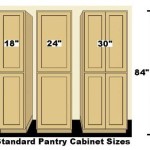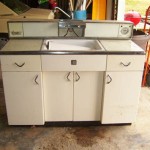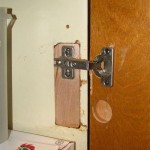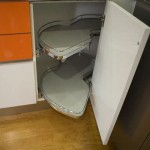Best Way to Clean Grime Off Kitchen Cabinets
Kitchen cabinets, subjected to daily cooking activities, inevitably accumulate grime. This accumulation comprises grease, food splatters, dust, and other airborne particles, forming a sticky layer that can be challenging to remove. Regular cleaning is essential not only for aesthetics but also for maintaining hygiene and prolonging the lifespan of the cabinetry. The optimal approach to cleaning this grime involves understanding the type of finish on your cabinets, selecting appropriate cleaning agents, and employing effective cleaning techniques.
The type of finish on kitchen cabinets significantly influences the cleaning method. Cabinets are typically finished with paint, stain, laminate, or a combination thereof. Painted cabinets, for instance, may be more susceptible to damage from harsh chemicals or abrasive cleaners. Laminate cabinets, while generally more durable, can still be scratched or dulled by improper cleaning. Stained wood cabinets can be damaged by excessive moisture or acidic cleaners. Therefore, identifying the cabinet finish is the crucial first step in selecting the appropriate cleaning strategy.
The accumulation of grime is often exacerbated by the environment. Kitchens with poor ventilation tend to have higher levels of airborne grease and moisture, which contribute to the rapid buildup of grime on all surfaces, including cabinets. Cooking habits also play a significant role. Frequent frying or sautéing, for example, generates more grease than boiling or baking. Furthermore, neglecting regular cleaning allows grime to accumulate and harden, making it more difficult to remove over time.
Before commencing any cleaning process, it's advisable to test the chosen cleaning solution on an inconspicuous area of the cabinet, such as the inside of a door or drawer. This precaution helps to ensure that the solution does not damage the finish or cause discoloration. If the test area shows no adverse reaction, the solution can be safely used on the rest of the cabinets.
Choosing the Right Cleaning Solution
Various cleaning solutions can effectively remove grime from kitchen cabinets. The selection should be based on the type of finish and the severity of the grime. Commercial cleaners specifically designed for kitchen cabinets are readily available, but homemade solutions can also be effective and often more economical and environmentally friendly.
One effective homemade solution involves combining warm water with a mild dish soap. The key is to use a soap that is formulated to cut through grease without being overly harsh. Avoid using soaps that contain abrasive particles or strong chemicals, as these can damage the cabinet finish. A ratio of one to two teaspoons of dish soap per gallon of warm water is generally sufficient.
For more stubborn grime, a solution of baking soda and water can be used. Baking soda is a mild abrasive that can help to loosen hardened grease and food particles. To create this solution, mix baking soda with enough water to form a paste. Apply the paste to the grimy areas, allow it to sit for a few minutes, and then gently scrub with a soft cloth or sponge. Rinse thoroughly with clean water and dry with a clean towel.
Vinegar is another popular cleaning agent due to its acidic properties, which can help to dissolve grease and grime. However, vinegar should be used with caution, especially on painted or varnished surfaces, as it can potentially damage these finishes. A diluted vinegar solution (one part vinegar to one part water) is generally safe for most surfaces, but it's always best to test it in an inconspicuous area first.
For particularly stubborn grime, a solution of borax and water can be used. Borax is a natural mineral with strong cleaning properties. Mix borax with warm water until it is dissolved. Apply the solution to the grimy areas, allow it to sit for a few minutes, and then scrub gently. Rinse thoroughly with clean water and dry with a clean towel. Borax can be irritating to the skin, so it's recommended to wear gloves when using it.
Regardless of the cleaning solution chosen, it's crucial to avoid using abrasive cleaners or scrub brushes. These can scratch or dull the cabinet finish. Instead, opt for soft cloths, sponges, or microfiber cloths. Microfiber cloths are particularly effective at trapping dirt and grease without scratching the surface.
Effective Cleaning Techniques
The effectiveness of cleaning kitchen cabinets depends not only on the cleaning solution but also on the technique employed. The goal is to remove the grime without damaging the cabinet finish. Start by removing any loose debris or dust from the cabinet surfaces. This can be done with a dry cloth, a vacuum cleaner with a brush attachment, or a duster.
Next, dampen a soft cloth or sponge with the chosen cleaning solution. Wring out the cloth or sponge to remove excess moisture. Avoid using a dripping wet cloth, as this can cause water damage to the cabinets, especially along the edges and seams. Wipe the cabinets in a gentle, circular motion, focusing on the areas with the most grime. Avoid scrubbing too hard, as this can damage the finish.
For areas with stubborn grime, allow the cleaning solution to sit on the surface for a few minutes before wiping. This will give the solution time to penetrate and loosen the grime. For particularly difficult spots, you may need to repeat the cleaning process several times.
After wiping the cabinets with the cleaning solution, rinse them thoroughly with clean water. Use a clean, damp cloth to remove any remaining soap residue. Failure to rinse properly can leave a sticky film on the cabinets, which can attract more dirt and grime. It's imperative to change the rinsing water frequently to ensure that it remains clean.
Finally, dry the cabinets thoroughly with a clean, dry towel. This will prevent water spots and streaks. Buffing the cabinets with a clean, dry microfiber cloth can also help to restore their shine. Make sure all surfaces, including doors, drawers, and hardware are completely dry before closing them. Moisture trapped inside can lead to warping or mildew growth.
When cleaning kitchen cabinets, pay attention to the hardware, such as knobs and pulls. These areas often accumulate grime and fingerprints. Clean the hardware with the same cleaning solution used for the cabinets, or use a specialized metal cleaner if necessary. Remove the hardware periodically to clean behind them thoroughly.
Maintaining Cleanliness and Preventing Future Grime Buildup
Regular cleaning is the key to preventing excessive grime buildup on kitchen cabinets. A quick wipe-down once a week can significantly reduce the amount of grime that accumulates. This maintenance cleaning should focus on areas that are most prone to getting dirty, such as around the stove and sink.
Improving ventilation in the kitchen can also help to reduce grime buildup. Using the exhaust fan while cooking can help to remove airborne grease and moisture. If the kitchen lacks an exhaust fan, consider installing one or opening a window to improve ventilation.
Protecting cabinets from splatters and spills is another effective way to prevent grime buildup. Using splatter screens when frying or sautéing can help to contain grease. Wiping up spills immediately can prevent them from drying and hardening into stubborn grime.
Consider applying a protective coating to the cabinets, such as a wax or polish specifically designed for kitchen cabinets. This can help to repel grease and dirt, making it easier to clean the cabinets in the future. Be sure to follow the manufacturer's instructions when applying any protective coating.
Store cleaning supplies in a convenient location in the kitchen so they are readily available for quick cleanups. This encourages frequent cleaning and prevents grime from accumulating to difficult-to-remove levels. Keeping a spray bottle with a mild cleaning solution and a microfiber cloth within easy reach can facilitate regular wipe-downs.
By understanding the type of finish on your cabinets, selecting appropriate cleaning agents, employing effective cleaning techniques, and maintaining a regular cleaning schedule, you can effectively remove grime from your kitchen cabinets and keep them looking clean and well-maintained for years to come.

How To Clean Kitchen Cabinets Everyday Skate

How To Remove Grease From Kitchen Cabinets 3 Methods Bob Vila

Get Grease Off Kitchen Cabinets Easy And Naturally

How To Clean Sticky Grease Off Kitchen Cabinets Ovenclean

Best Ways To Clean Grease Stains Off Kitchen Cabinets

Clean Kitchen Cabinets Off With These Tips And Hints

How Remove Grease From Wood Kitchen Cabinets

Get Grease Off Kitchen Cabinets Easy And Naturally

3 Ways To Clean Greasy Kitchen Cabinets Wikihow

How To Clean Kitchen Cabinets In A Few Easy Steps Hunker Cleaners Homemade House Cleaning Tips
Related Posts








